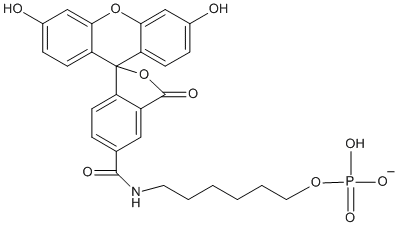Fluorescein dyes fluoresce in the green-blue region of the visible spectrum, and are most efficiently quenched by BHQ-1. There are several ways of labelling an oligonucleotide with fluorescein-type dyes, and the choice of label is diverse, depending on the degree of chlorination of the aromatic rings. This determines the fluorescence emission of the dye.
5'-Fluorescein-CE Phosphoramidite (or “6-FAM”), derived from the single isomer 6 carboxyfluorescein is probably the most commonly used phosphoramidite, but 5'-Hexachloro-fluorescein-CE Phosphoramidite (HEX) and 5’ Tetrachlorofluorescein-CE Phosphoramidite (TET), can also be used to efficiently label an oligonucleotide at the 5'-end, with differing emission maxima.
While both 6-Fluorescein-CE Phosphoramidite and Fluorescein-CE Phosphoramidite incorporate the same fluorescent dye as 6-FAM, the linking backbone differs. The former has a 1,3-diol structure, where the additional OH is protected with DMTr. This not only allows coupling efficiency monitoring by DMTr release, it allows the possibility of multiple additions within the oligo for use in, e.g. chromosome painting. However, this often requires a linker (e.g. spacer-18) to be incorporated between each addition to prevent self-quenching of fluorescein. In the same way spacer-C3 is used to mimic the distance between the 3’ and 5'-O of dR, the 1,3-diol arrangement of 6-Fluorescein-CE Phosphoramidite provides the same scenario. It must be noted that, as with spacer-C3, a distortion of the backbone occurs, particularly with multiple incorporations.
Fluorescein-CE Phosphoramidite has a thiourea linkage which mimics the original method of incorporating fluorescein to an amino-modified oligo. It must be noted however that the linkage is attached via the 5 position of the ring system in this case.
Internal sequence additions of Fluorescein are achieved using Fluorescein-dT. Again, multiple additions can be carried out but the spacing between each fluorescein-dT is crucial to prevent self-quenching.
Labelling the 3'-end of an oligo with fluorescein can be achieved by a variety of solid supports, with spacer and dT options. Notably, the 3'-(6-FAM) CPG also allows the effective blockage of the 3'-terminus from polymerase extension, as well as exonuclease activity.
Lastly, 5,6-Fluorescein-OH carboxylic acid product is a mixed isomer free acid which can be used for labelling free amines on proteins.
